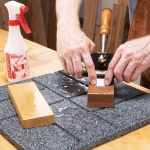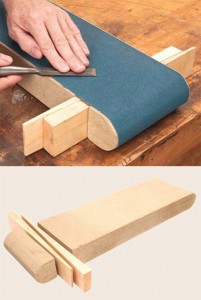We may receive a commission when you use our affiliate links. However, this does not impact our recommendations.
 It goes without saying that there is a renewed interest in hand tool woodworking, and much has been written on the topic, and that’s great because there really is a lot to know about these tools that are “new” to many woodworkers. That said, my experience with hand tools has taught me one thing – Keep it Sharp! Whether a saw, knife or blade, sharp tools cut more accurately, safely and cleanly. I’ve also learned that I really don’t enjoy the sharpening process all that much, even though I understand that I need to do it. Sort of like getting the dishes out of the sink. You know you have to do it, and you appreciate it when it’s done. You just have to roll the sleeves up and get to work! So, to help all of our current and potential hand tool woodworkers, I’ve included a tip here from the Sharpening Shortcuts chapter in Hand Tool Fundamentals. The other tips and techniques found in this e-book should shorten your sharpening time, and get you back to woodworking. Enjoy!
It goes without saying that there is a renewed interest in hand tool woodworking, and much has been written on the topic, and that’s great because there really is a lot to know about these tools that are “new” to many woodworkers. That said, my experience with hand tools has taught me one thing – Keep it Sharp! Whether a saw, knife or blade, sharp tools cut more accurately, safely and cleanly. I’ve also learned that I really don’t enjoy the sharpening process all that much, even though I understand that I need to do it. Sort of like getting the dishes out of the sink. You know you have to do it, and you appreciate it when it’s done. You just have to roll the sleeves up and get to work! So, to help all of our current and potential hand tool woodworkers, I’ve included a tip here from the Sharpening Shortcuts chapter in Hand Tool Fundamentals. The other tips and techniques found in this e-book should shorten your sharpening time, and get you back to woodworking. Enjoy!
Sanding Belt Lapping Jig
 You can chew up a lot of sandpaper flattening a plane iron, a large chisel or the bottom of a plane. It makes sense to use paper that lasts a long time–like a sanding belt. But, if you cut a belt to lay open, it won’t sit flat, because its backing is too stiff.
You can chew up a lot of sandpaper flattening a plane iron, a large chisel or the bottom of a plane. It makes sense to use paper that lasts a long time–like a sanding belt. But, if you cut a belt to lay open, it won’t sit flat, because its backing is too stiff.
To overcome this problem, I devised a jig that stretches a belt very tight. I only use it with coarse grits–60, 80, and 100–for tools that need a lot of flattening. The jig is doublesided, of course, so you’ll use the whole belt. It won’t slip when you’re flattening, because the abrasive on the bottom grips your workbench.
I made this jig for the 6×48 belts that go on my combination disc/belt sander, but it could be any size. The body consists of three 3/4″ MDF pieces laminated together. After gluing, flatten the faces by rubbing the blank on sheets of sandpaper taped to the top of a tablesaw. Round the ends by making 45° cuts on both ends of the blank, then soften the sharp corners with a file. Cut off the short end and make opposing wedges to pull the belt tight.
Eager to push your hand tool techniques even further? Order your copy of American Woodworker’s Hand Tool Fundamentals. This woodworking guide will put you well on your way to achieving handcrafted excellence in your woodworking projects. Begin with the essentials, like learning which tools and techniques are necessary to get started, as well ensuring these essentials are an everyday component of your shop. Once you’ve established the necessities, discover how to tune your tools so they’re consistently in prime working condition. Available in paperback and e-book formats today!
Here are some supplies and tools we find essential in our everyday work around the shop. We may receive a commission from sales referred by our links; however, we have carefully selected these products for their usefulness and quality.








